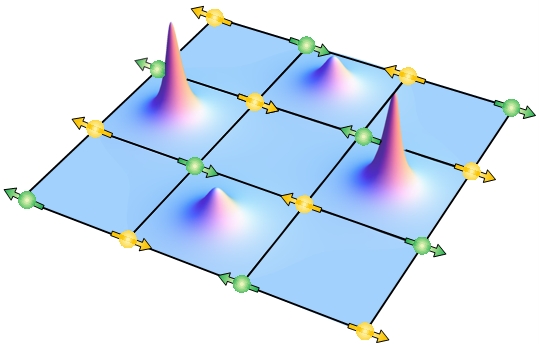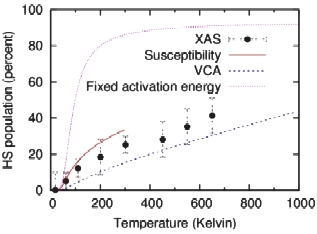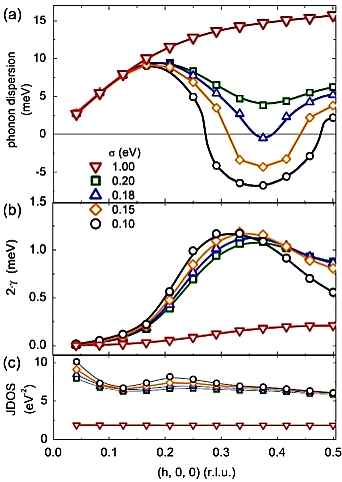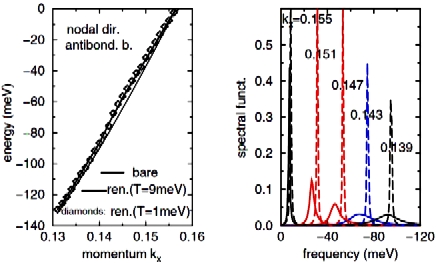Working Group Theory of Electronic Correlations and Collective Phenomena
|
Nematic Order and Fluctuations in Fe-based Superconductors
Fe-based superconductors are fascinating new materials where the superconducting state is most likely due to an unconventional pairing mechanism. The materials are characterized by a complex phase diagram where magnetic, structural and superconducting phases comepe with each other. The structural order in these systems was shown to be related to a nematic state, a state where rotational symmetry is broken while no new translation symmetry breaking occurs.
Although the existence of nematic order in Fe-based superconductors is now a well-established experimental fact, its origin remains controversial. Nematic order breaks the discrete lattice rotational symmetry by making the x and y directions in the Fe plane non-equivalent. This can happen because of (i) a tetragonal to orthorhombic structural transition, (ii) a spontaneous breaking of an orbital symmetry, or (iii) a spontaneous development of an Ising-type spin-nematic order - a magnetic state that breaks rotational symmetry but preserves time-reversal symmetry. The Landau theory of phase transitions dictates that the development of one of these orders should immediately induce the other two, making the origin of nematicity a physics realization of a "chicken and egg problem".
In our work we demonstrated that experimental and theoretical evidence strongly points to the electronic rather than phononic mechanism, placing the nematic order in the class of correlation-driven electronic instabilities, like superconductivity and density-wave transitions. In particular we analyzed transport, magnetic, and elastic properties within a spin driven scenario and showed that this is a very viable approach that can simultaneously describe a multitute of experimental observations.
Our work is done in close collaboration with the experimental colleagues of the New Materials, Transport, Thermodynamics and Mesoscopics working group of IQMT. In addition we collaborate with theorists in Germany (Bochum and Dresden) and worldwide (Minnesota, Wisconsin, Rutgers).
|
Electronic Correlations in Transition Metal Oxides
Transition metal oxides form a class of materials which is at the focus of much current interest. One particular challenging aspect in their theoretical description is the strong Coulomb repulsion between electrons in their partially filled 3d shells, which poses a severe problem even for otherwise highly successful methods of electronic structure calculation.
It is known since the pioneering work of Fujimori und Minami (Phys. Rev. B 30 (1984) 957) that momentum-integrated valence band photoemission spectra of such compounds can be reproduced very well by treating a single transition metal ion in an octahedral cage of nearest neighbor oxygen atoms in the framework of the configuration interaction method. The agreement with experiment in fact is so good that comparison between measured and calculated X-ray absorption spectra by now is a standard technique in chemistry and materials science.
In our group this cluster method was developed into a band structure technique for strongly correlated materials by extracting the electronic self-energy - an energy-dependent correction which describes the effect of interaction between electrons - from the solution of the cluster problem and using this as a `trial self-energy' for the lattice system. The theoretical basis is given by the so-called Variational Cluster Approximation proposed by Potthoff (Eur. Phys. J. B 36 (2003) 335) which was applied by other groups to model Hamiltonians such as the Hubbard model with considerable success.
At the IQMT a version of the theory was developed which allows to combine realistic band structures and the exact multiplet theory for transition metal 3d shells and thus perform band structure calculations for strongly correlated insulators like NiO, CoO or MnO. In addition to the calculation of band structures this theory also allows the study of thermodynamical quantities and phase transition, as exemplified by the theoretical treatment of the spin state transition in LaCoO3.
|
Lattice Dynamics and Electron-Phonon Interaction
Modern ab initio methods enable nowadays a detailed calculation of electronic structure and lattice dynamics for materials with complex crystal structure. In addition, the electron-phonon coupling (EPC) can be accessed on a microscopic level. These quantities determine a variety of fundamental properties of a solid, and are key for understanding phenomena like superconductivity and structural phase transitions.
A current research area are the iron-pnictide superconductors. This class of materials is characterized by unusually high superconducting transition temperatures and complex phase diagrams involving structural, magnetic and superconducting phases. In close collaboration with our neutron scattering group, we could elucidate the vibrational spectra of several representative members. Our theoretical studies revealed that the iron pnictides exhibit a sensitive interplay of structure and magnetism which is relected in the lattice dynamics. Furthermore, calculation of the phonon-mediated pairing interaction showed that EPC is unlikely to be responsible for superconductivity, giving support for an unconventional pairing mechanism. A further consequence if the EPC is a renormalization of phonons, which is expressed by a reduction of its frequency and by a finite lifetime. A sufficiently large coupling can drive a phonon to zero frequency (soft mode), resulting in an instability of the crystal structure. Such an electronically driven structural phase transition, also called Peierls or charge-density-wave instability, is not well understood for materials with complex electronic structure. NbSe2 and TiSe2 are two prominent examples showing such instabilities. Our theoretical studies of the soft-mode behavior in connection with inelastic x-ray scattering experiments revealed qualitative differences between these two compounds. While the classical picture of an electronically driven instability seems to hold for TiSe2, the momentum dependence of the EPC plays a prominent role for NbSe2.
Another research topic in our group are the influence of relativistic corrections on lattice dynamics and EPC, which is important for compounds containing heavy elements. For the classical superconductor lead we could show that spin-orbit interaction significantly enhances the pairing interaction, and a correct quantitative description of its superconducting properties is achieved only when these relativistic corrections are taken into account.
|
Electronic Self-Energy Effects
The electron-phonon coupling of the electronic quasiparticles to lattice vibrations renormalizes states in particular in the vicinity of the Fermi energy. This effect can be described quantitatively by our ab-initio techniques. For the high-temperature superconductor YBa2Cu3O7 we demonstrated that the EPC modifies the quasiparticle dispersion but that the resulting kink is significantly smaller than what is observed experimentally which excludes classical electron-phonon coupling as major physical origin.
We apply this technique also in studies of electronic surface states which are readily accessible with available experimental techniques, e.g., angle-resolved photoemission. For the Pd(111) surface we could thus explain the experimental observation of an unusually long lifetime of an unoccupied Shockley state as a result of a lack of phonon-related decay channels. Occupied states show a significantly higher coupling to phonons.
|
| Selected Publications: |
| (12) R. Heid et al., Phys. Rev. Lett. 100 (2008) 137001 |
| (13) I. Yu. Sklyadneva et al., Phys. Rev. B 80 (2009) 45429 |




